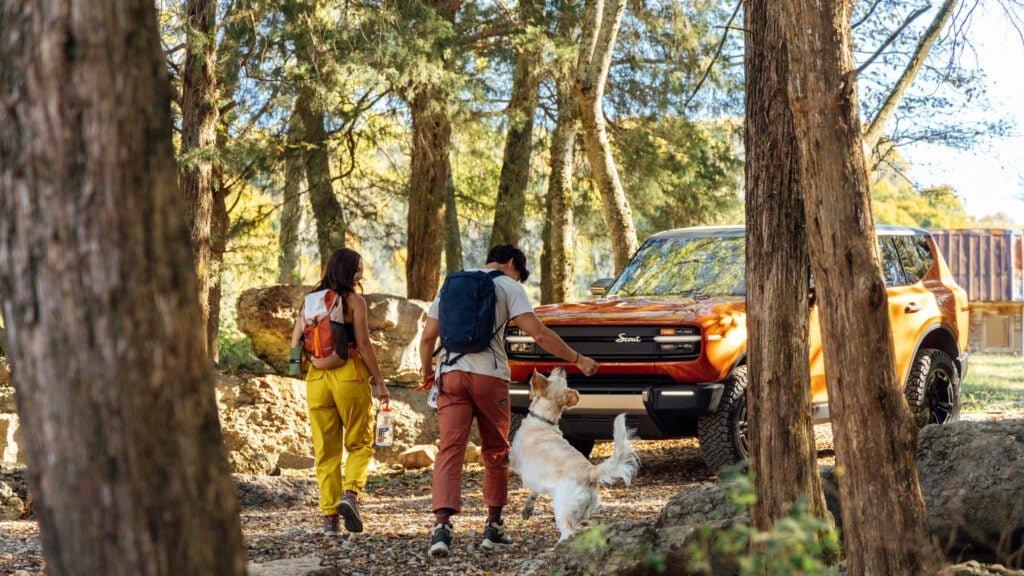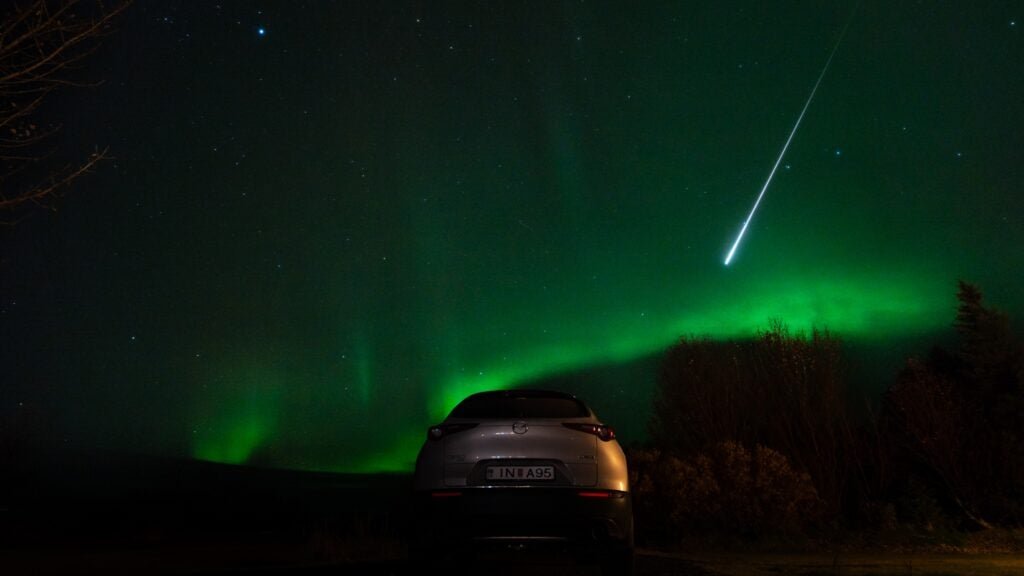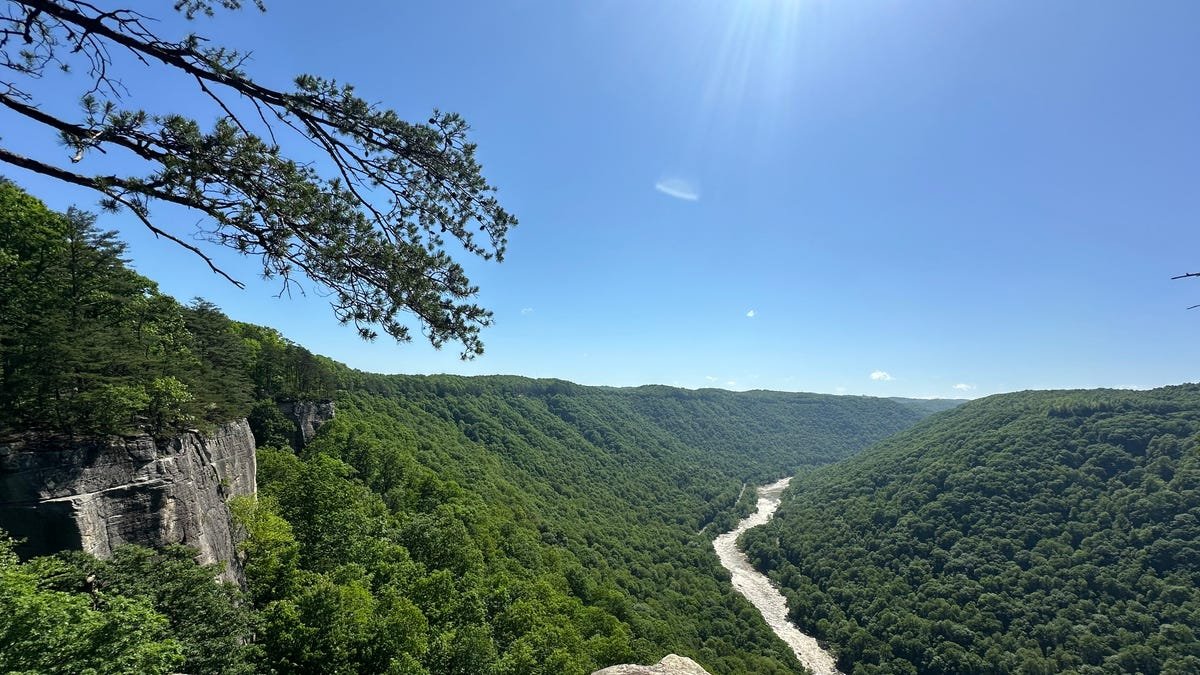Destinations & Things To Do
An Iconic Brand Aims to Change America’s Truck and SUV Industry—Again

People across the United States took to the outdoors like never before during the country’s adventure boom in the 1960s and ’70s. It was an unprecedented era of exploration, and it needed a vehicle to match. Enter International Harvester’s Scout® vehicles. Born from a desire to create a truck that could go anywhere and do anything, the first Scout model debuted in 1960. Over the next two decades, the brand set a new standard for durability and versatility. For work, play, and family duty, the Scout vehicles were embraced by everyone from farmers to boaters and became a symbol of freedom and rugged independence for a generation of adventurers. Now, Scout Motors is reimagining the brand, connecting its heritage to modern ingenuity. We caught up with Ryan Decker, vice president of strategy and brand at Scout Motors, to get the details on how this iconic vehicle is leveraging new technology and building on its vibrant community.
Outside: What’s the story of Scout’s rebirth?
Ryan Decker: Scout Motors was formed in 2022 to craft the next era of Scout vehicles, rooted in the same tradition that made the original an American icon. The Scout brand and vehicles have always been about community. One of Scout Motors’ first priorities was to invite nearly a dozen Scout community members to a gathering to say thanks for keeping the Scout spirit alive, show them our early design models, and listen to their feedback. Beyond that, our original intent was clear: 1) Reimagine the iconic Scout brand and grow its community of passionate fans, and 2) design and develop highly credible vehicles in the core of the U.S. market.
What makes Scout Motors unique?
The Scout products and brand can be summarized as “Connection Machines.” The Scout vehicles connect American truck heritage with modern ingenuity. Body-on-frame architecture and a solid rear axle meet electric torque and over-the-air updates. Including features such as an optional bench seat and intuitive, easy-to-use technology, Scout vehicles connect drivers with their passengers. Tactile switches, knobs, and handles also help connect Scout drivers with their vehicle.
Another priority is that Scout Motors, as a company, connects with its community. Whether we are engaging on our community forums, visiting IH Scout and All Truck Nationals in Springfield, Ohio, or sponsoring the Vintage Race Terra for the Baja 1000 rally, we want to create moments of meaningful connection between Scout Motors and the broader Scout community—to listen, to learn from them, and to make new fans.
What’s ahead for Scout Motors?
Like everything we’ve done to date, the next chapter at Scout Motors will be defined by rolled-up sleeves, hard work, and the intent to build something lasting. We’re building a multibillion-dollar production center in Blythewood, South Carolina, that spans over 1,000 acres and is projected to create more than 4,000 good-paying jobs and produce 200,000-plus vehicles per year. We’re designing and developing the Traveler™ SUV and Terra™ pickup truck. We’re building a retail model that offers trust, transparency, and the best possible customer experience. Ultimately, we’re building a totally new system to deliver vehicles, service them, and earn customer loyalty.
What models are launching first?
Scout Motors will launch the Scout Traveler SUV and Terra truck. The Traveler and Terra are designed to compete in the core of the U.S. market—rugged SUVs and full-size trucks. Both products share priorities, the first being to honor the credibility that Scout vehicles delivered from 1961 to 1980 and inject that heritage with modern performance and technology. From payload and towing to torque and zero-to-60 times to accessories and built-in power outlets, the Scout Traveler and Terra will be able to work hard and play hard. Both vehicles will be available in all-electric models or with the Harvester™ powertrain, which includes a gas-powered generator projected to give Scout vehicles more than 500 miles of combined range. Lastly, Scout vehicles were always best experienced together. An optional bench seat and our Community UX ensure that the Scout Traveler and Terra remain Connection Machines.
How do you join the Scout community?
First, we hope you do. We want to hear from you directly, and there are many ways you can engage with our team. Similar to how we showed up at the Outside Festival, we plan on getting the Scout brand and products out into the world to meet our customers and community where they are. Come see us and say hello! Second, we are building a highly engaged community forum. We participate in online discussions daily and invite you to engage with us on social media. Third, you can subscribe to our email communications at scoutmotors.com—we plan on providing meaningful updates about our company’s progress to our handraisers. And finally, you can reserve your spot in line for a Scout Traveler or Terra—or both—at scoutmotors.com.
Scout Motors was formed to craft the next era of trucks and rugged SUVs rooted in the same tradition that made the original Scout vehicle an American icon. Scout Motors is revitalizing a legend and returning manufacturing to American shores. Initial production is targeted to begin at the Scout Motors Production Center near Columbia, South Carolina, in 2027.
Destinations & Things To Do
China Expands Visa Free Access To Top Destinations Like Bahrain, Bahamas, Oman, Kuwait, Saudi Arabia And Many More: How The Global Tourism Will Be Impacted

Sunday, July 27, 2025
In 2025 Chinese passport has joint the list of passports people can holder have access to travel without or with visa on arrival in 83 countries, which include some popular countries like: Thailand, Qatar, the Maldives, Albania and Singapore. This is a game changer in global migration and it is made possible by increasing diplomatic clout from China which means that the latter is able to enjoy more mobility of its citizens. The Henley Passport Index reports that China sits at 60th position amongst passports in the world based on the strength of the passport, a striking improvement from the past and providing the Chinese more visa free or visa-on-arrival destinations than in previous years.
This broadened mobility is expected to be a potential force not only for reinforcing Chinese outbound tourism but also for shifting international travel patterns. China’s increased propensity to travel will have several implications, as the country starts opening more travel destinations. Among the most significant impacts on the countries providing visa free access, it will increase overall visitor numbers, which will be beneficial for their travel sectors.
China’s Rank at the Henley Passport Index in 2025
The Henley Passport Index ranks China 60th in its 2025 index, reflecting a noticeable improvement in the travel freedom of Chinese citizens. This enhanced mobility allows Chinese passport holders to visit more countries without needing a visa, showcasing China’s growing influence and global relations. Compared to previous years, when Chinese passports were more restricted, the increased number of visa free destinations now enables easier travel to several countries across Asia, Europe, and Africa.
China’s rise in the Henley Passport Index is directly linked to its expanded diplomatic efforts and economic influence globally. As China strengthens ties with countries worldwide, Chinese citizens are reaping the benefits through more accessible travel options.
Countries Offering Visa Free Access to Chinese Passport Holders
As of 2025, Chinese passport holders can travel visa free or with visa-on-arrival access to 83 countries. This includes key destinations that have strategic agreements with China, offering easier access to some of the world’s most popular tourist locations. Here are some notable countries where Chinese citizens can travel without a visa: Bahrain, Bahamas, Oman, Kuwait, Saudi Arabia, Maldives, Armenia, Serbia, Bolivia, Belarus, Cuba and many more.
These countries are among the many now open to Chinese passport holders, reflecting China’s strengthened diplomatic and economic ties with nations across the globe. This expanded access encourages Chinese travellers to explore a wider range of destinations, contributing to a shift in global tourism patterns.
Impact of China’s Visa Free Access on Global Tourism
The visa free access granted to Chinese passport holders is set to have a profound impact on global tourism. With China being one of the largest outbound tourism markets in the world, the increased number of accessible countries will lead to more Chinese tourists visiting international destinations. Countries such as Thailand and Singapore will likely see a surge in Chinese arrivals, bolstering their local economies through spending on accommodation, transportation, and attractions.
On the other hand, countries that have not yet opened their borders to Chinese tourists may find themselves at a competitive disadvantage. As Chinese travellers gain easier access to a growing number of destinations, nations without visa-friendly policies may lose out on a significant portion of this lucrative market. Therefore, countries eager to attract Chinese tourists must reconsider their visa regulations to stay competitive in the tourism industry.
The opening of borders to Chinese passport holders also has the potential to diversify global tourism. With more destinations available, Chinese travellers may seek out new, unique experiences in countries that were previously less accessible. This could shift global travel trends, with countries offering unique attractions or cultural experiences seeing a rise in Chinese visitors.
Future Trends and the Role of China in Global Tourism
Looking to the future, the broadening of visa free access to Chinese passport holders is anticipated to continue to stimulate global tourism. The number of countries that grant visa free or visa-on-arrival access or electronic travel authority to Chinese citizens will presumably grow as China develops its diplomacy. This factor of increased mobility with regard to outbound travel will create and augment large travel opportunities for the Chinese, and sustain the long-term trend of China’s outbound tourism growth.
Also, the growing influx of Chinese tourists is expected to raise the stakes for tourist destinations competing for this affluent group. Those countries that can make it as easy as possible for the Chinese to visit will potentially gain massively in economic terms. On the other hand, countries that fail to adapt could be left behind in one of the world’s largest and most dynamic travel markets.
Conclusion
China’s passport now provides visa free access or visa-on-arrival access to 83 countries, representing a significant shift in global tourism dynamics. With China ranked 60th in the Henley Passport Index, the increasing number of nations granting access to its citizens positions Chinese travellers to play a pivotal role in shaping the global tourism landscape. This expanded mobility not only offers substantial benefits to Chinese passport holders but also presents new opportunities for international destinations, influencing travel patterns and behaviours in the years to come.
Destinations & Things To Do
Here’s How to See the Perseid Meteor Shower in 2025

There’s a reason stargazers love the Perseids. The meteor shower can spark up to 100 shooting stars per hour at peak during prime viewing years, with numerous sightings of eye-popping fireballs—the name for especially vivid and colorful meteors that can reach the same luminosity as Venus.
The Perseids, which peak in August, do come with a slight hitch: the 86-percent illuminated moon will hinder the shower’s view. But that’s no reason to skip it. Instead, rethink your Perseid-viewing plan.
Read on for your 2025 strategy to catch the buzzed-about Perseids, along with other interstellar marvels that will join them, from concurrent meteor showers to the year’s best views of the Milky Way.
What’s the Best Time to Watch the Perseid Meteor Shower in 2025?
This year’s Perseids runs from July 17 to August 23 and will peak overnight from August 12 to 13. Typically, it’s best to view a meteor shower during the stretch of highest activity, but that’s not the case this year. The meteor shower crescendos just three days after the full moon. Since lunar light pollution will hide the milder meteors, only the brightest shooting stars and fireballs will be visible.
That’s why many backyard astronomers are switching gears and watching the Perseids off-peak, in the nights and weeks leading up to that August 12 to 13 timeframe. July 29 into 30 is particularly promising, as the moon is only a quarter full, it sets around midnight (right when the Perseids action kicks into gear), and this coincides with other active meteor showers.
Improve Your Perseids View with Other Meteor Showers
While the Perseids won’t produce a flurry of 50 to 100 shooting stars in late July and early August, the timing does provide the chance to watch for four meteor showers in one night, including two that will peak from July 29 to 30.
Here are the four coinciding summer meteor showers, including when to watch, what to look for, and where you’ll see them in the sky (also known as the radiant). I recommend downloading a stargazing app for night-sky navigation.
- Alpha Capricornids: July 3 to August 15
- Peak: July 29 to 30
- Look near: Capricornus constellation low in the southeast sky
- You’ll see: A mild shower with only around five meteors per hour during peak, but the potential for some dramatic fireballs.
- Southern Delta Aquariids: July 18 to August 12
- Peak: July 29 to 30
- Look near: Aquarius constellation low in the southern sky
- You’ll see: Around seven meteors per hour under dark skies. To note: This one’s best viewed in the southern hemisphere and the southern part of the northern hemisphere.
- Perseids: July 17 to August 23
- Peak: Aug 12 to 13
- Look near: Perseus constellation in the northeast sky
- You’ll see: Up to 100 meteors per hour under pristine conditions, although fewer are expected in 2025 due to the bright moon. Watch for fireballs, too.
- Eta Eridanids: July 31 to Aug 19
- Peak: Aug 7 to 8
- Look near: Eridanus constellation low in the southeast sky
- You’ll see: A minor shower with about three fast meteors per hour at peak.
How to Watch a Meteor Shower: Tips and Tricks
Admiring a meteor shower requires a bit of planning, from choosing a strategic viewpoint to pinpointing red flags to avoid.
1. Avoid light pollution.
Just like with aurora hunting, you’ll want to avoid light pollution when chasing meteor showers. The show gets most active and brilliant under inky skies; that’s why I’m planning to watch the sky confetti from an inky lake in New York’s Adirondacks, followed by Quebec’s Mont-Mégantic, the first DarkSky Reserve in the world. Try a resource like this light pollution map to find a dark-sky viewing place close to home.
2. Shield the moon.
If you do choose to pursue the Perseids at peak, use something—your hand, a folder, a blanket—to shield your eyes from the moon. It won’t fix the situation, but it will help you retain your night vision.
3. Use a red-light flashlight.
Speaking of night vision, it’s important to dim your phone (or use this red-screen trick) and either wrap your bright-white flashlight in red cellophane or invest in a red-light lamp. Red light is easier on our eyes at night; after exposure to white beams, or a full-glow smartphone screen, our eyes require around 30 minutes to readjust to the dark.
4. Look for wide-open vistas.
Since the shooting stars could appear all over the sky, it’s wise to choose a lookout point with minimal overhead obstructions. Instead of a thick forest, for example, scout for a hilltop, desert, or field with clear sky views.
5. Consider air quality.
Unfortunately, wildfires have wreaked havoc on the Southwest’s national parks this summer. The correlating smoke is bad for your health, and its haze can obscure your night-sky views. Keep an eye on air quality updates and consider another viewpoint if thick wildfire smoke is in the forecast.
Where to See the Perseids
In most cases, like with the Perseids, the best viewing stretches from around midnight until dawn. That means you’ll be out and about into the wee hours of the morning—unless you strategize your sleep. I aim for campgrounds, glamping sites, and even low-light hotels located within an area with minimal light pollution.
And there are plenty of prime meteor-shower accommodations still available (as of publication) throughout North America, whether you’re heading out for the July 29 to 30 timing, the August 12 to 13 Perseids peak, or both.
1. ULUM Moab, Utah
In late 2023, light pollution authority DarkSky International launched a new program to certify accommodations that protect their pristine nightscapes. ULUM Moab, a glamping getaway set 40 miles south of Arches National Park, is one of the organization’s first DarkSky-certified lodges. This stamp-of-approval means you can catch the night sky marvels, from the Milky Way to the dimmer Perseids, right from camp. Or, watch the wonder nearby at Arches or Canyonlands National Parks. Suites run from $549 per night; for a less-expensive option, try Under Canvas Moab (from $199), another DarkSky-certified glamping location in Moab.
2. Hébergement aux Cinq Sens, Quebec
In 2007, Quebec’s Mont-Mégantic National Park became the world’s first International Dark Sky Reserve, and it’s become one of Canada’s best-known astronomy spots. Hébergement aux Cinq Sens (from $98), a collection of tiny homes and yurts, lies in the heart of this pine-dotted park, which offers dozens of hiking trails for daytime adventure. It’s a great Perseids basecamp, with wide-open gathering spaces from the hotel grounds and quick access to the park’s sky-watching hub, the ASTROLab, just 16 miles away.
3. Hell Creek Campground, Montana
Nabbing a campsite in Glacier National Park may be trying, but out east, Montana’s remote and inky-sky campground options abound. Try Hell Creek Campground (from $37.50 per night), located in a scenic recreational area along angling haven Fort Peck Lake. The property offers dozens of campsites with virtually zero light pollution and wide-open sky views above the still water and distant peaks.
4. Bruneau Dunes State Park, Idaho
Camp in southern Idaho’s Bruneau Dunes State Park, a DarkSky-certified destination with an onsite public observatory and North America’s tallest single-structured sand dune. The park has two main campgrounds with unobstructed celestial views: Broken Wheel and Eagle Cove (from $25). Both have plenty of availability for the mid-August Perseids peak, with the chance to enjoy shooting stars by night and sandboarding under the sun.
5. Buffalo National River, Arkansas
The Buffalo National River draws paddlers with 135 scenic miles of undammed water. Come dusk, this DarkSky Park is also a favorite among astronomy enthusiasts, with pristine nightscapes and plenty of camping options to admire the heavens. Thick oak and hickory forests do make it tough to watch for meteors in some overnight spots, but Tyler Bend Campground (from $20) is a smart option with relatively minimal forest cover and plenty of summer availability.
6. Beaver Island Retreat, Michigan
Last year, State Wildlife Research Area on Beaver Island became Michigan’s first International Dark Sky Sanctuary, and the Lake Michigan getaway has a host of potential sky sights on offer. Pass your pre-shower hours with birding, paddling, or lake snorkeling. When it’s time to catch the show, stay overnight just north of the sanctuary, at glamping hub Beaver Island Retreats (from $249), where guests have ample space to spot shooting stars, fireballs, and, on lucky nights, the northern lights.
Destinations & Things To Do
Why West Virginia is the underrated US adventure capital

How two border collies help keep planes safe at a West Virginia airport
Meet Hercules and Ned, two border collies keeping West Virginia’s busiest airport safe while spreading smiles.
- West Virginia offers a variety of outdoor activities, including hiking, rock climbing, and whitewater rafting.
- The New River Gorge is a popular destination for outdoor adventures, with trails like the Endless Wall and opportunities for climbing and rafting.
- Charleston, the state capital, serves as an urban hub with access to outdoor recreation areas and a growing food and brewery scene.
“Experience America” is a five-part series that showcases often-overlooked destinations and experiences in our backyard.
FAYETTEVILLE, West Virginia ― If you had told me in January I’d be going to West Virginia twice this year, I don’t think I would have believed you, but I’m so glad I can now say I have been.
West Virginia is an outdoor adventurer’s paradise, and although even locals don’t always take advantage of the resources right on their doorstep, the state is truly a hidden gem of the great outdoors.
“West Virginia is just often an underrated destination as a whole, and maybe not the first thought for a really high adventure destination,” Lindsey Funk, a public relations assistant at the West Virginia Department of Tourism, told me during my first visit, in May. For that, she said, even West Virginians often go elsewhere.
But the Mountain State is trying to remind residents and visitors alike that it’s a great place for any pace of outdoor adventure.
Hiking and nature
Probably the lowest barrier to entry for the outdoor adventure novice is a hike or a nature walk in West Virginia. The state and national parks, almost all of which are free to access, have nearly endless trails and scenic lookouts.
West Virginia is a year-round destination, with breathtaking foliage in the fall and gorgeous vistas the rest of the year, according to Funk.
“In the state as a whole, hiking is probably one of our most family-friendly activities,” she said.
From the Endless Wall trail in the New River Gorge to the West Virginia Waterfall trail – an official guide to the state’s most beautiful water features – there’s something for everyone. Just remember to bring a sturdy pair of shoes.
On a recent personal trip to the New River Gorge and Charleston this spring, I saw firsthand how stunning the scenery along the Endless Wall trail can be. With scenic vistas throughout the gorge, including a unique perspective on the famous bridge, hiking there is relatively low-intensity and well worth the payoff.
The entire trail is just under 5.5 miles out and back, according to AllTrails, but can easily be shortened after taking in some of the views.
High adventure: Climbing and rafting
For those seeking more adrenaline, West Virginia is also a great destination for rock climbing and whitewater rafting, both of which can be found in the New River Gorge.
During the spring trip, I had a chance to raft on the lower New River, with rapids up to Class V, thanks to heavy rain in the days leading up to the excursion.
With swift-moving water, the entire trip took around an hour and a half to two hours to cover about 14 miles, and the rapids were characterized primarily by big, rolling waves.
The guide on the trip, from ACE Whitewater Rafting, said water levels can significantly change the dynamics of the river, which is why it’s important to always travel with a guide. Whitewater rafting is an extreme sport, but guides make it much safer.
There are numerous outfits throughout the New River Gorge that provide guided whitewater rafting excursions.
Novice climbers may also want a guide or a more experienced buddy if they’re checking out the crags.
For rock climbers of all skill levels, West Virginia and the New River Gorge are also almost heaven.
Crags around Fayetteville offer opportunities for outdoor bouldering, top roping, sport and trad climbing for all skill levels. There are also opportunities for deep water soloing at Summersville Lake State Park during the summer.
I took a trip in July to join Queerclimbtastic, an LGBTQ+ rock climbing retreat held every summer in the New River Gorge, and saw firsthand how great the climbing opportunities are in the state. It was my first time climbing outside after years of indoor-only climbing, and I’m already excited to go back next year and explore other crags closer to home in the meantime.
Bike City, USA
Charleston is West Virginia’s urban gateway to the wilderness, about an hour from the New River Gorge. It’s also home to a professional circuit bike race and is trying to grow its presence as a destination for road and mountain biking.
The state’s capital is also a great place to use as a home base for a trip to West Virginia.
“Charleston’s more of a cityscape for us, a smaller city, but this is a great place for downtown shops and events,” Funk said. “But then, just an hour away, is so many acres of public land and those outdoor adventure options.”
Charleston has a budding food and brewery scene, an extensive farmer’s market and is also home to Mountain Stage, a long-running NPR program that broadcasts two hours of performed-live country music nationwide.
Winter sports
Funk said West Virginia is a year-round state and also has a handful of small ski resorts, which are great for beginners interested in trying out the sport.
“We are a four-season destination,” she said.
Jim and Cara Hocking are full-time travel content creators and said they visited Winter Place, one of West Virginia’s ski resorts, earlier this year with their four kids. Only Cara had skied before, and she said it was a great place for the rest of her family to learn.
“It was exactly what we needed, we had someone that was there that taught us the basics, taught our kids the basics,” Jim told me. “It was a perfect place to have your first skiing experience in my mind.”
How to get there and where to stay
The closest airport will depend on exactly where you’re going in the state, but for both of my trips to the New River Gorge, I flew into Charleston, the state capital of West Virginia. From there, it’s about an hour to an hour and a half drive to Fayetteville, which is a significant gateway to the Gorge’s outdoor recreation areas.
Lodging options in and around Fayetteville include campsites, cabin rentals, traditional hotels, B&Bs and more. Options are also available in Charleston for those looking for a more urban base camp for their travels.
Public transit options are limited, so visitors should plan to rent a car to get around.
The reporter on this story received access from West Virginia’s Department of Tourism. USA TODAY maintains editorial control of content.
Zach Wichter is a travel reporter and writes the Cruising Altitude column for USA TODAY. He is based in New York and you can reach him at zwichter@usatoday.com.
-

 Brand Stories6 days ago
Brand Stories6 days agoBloom Hotels: A Modern Vision of Hospitality Redefining Travel
-

 Brand Stories1 day ago
Brand Stories1 day agoCheQin.ai sets a new standard for hotel booking with its AI capabilities: empowering travellers to bargain, choose the best, and book with clarity.
-

 Destinations & Things To Do7 days ago
Destinations & Things To Do7 days agoUntouched Destinations: Stunning Hidden Gems You Must Visit
-

 AI in Travel7 days ago
AI in Travel7 days agoAI Travel Revolution: Must-Have Guide to the Best Experience
-

 Brand Stories3 weeks ago
Brand Stories3 weeks agoVoice AI Startup ElevenLabs Plans to Add Hubs Around the World
-

 Brand Stories2 weeks ago
Brand Stories2 weeks agoHow Elon Musk’s rogue Grok chatbot became a cautionary AI tale
-

 Destinations & Things To Do1 day ago
Destinations & Things To Do1 day agoThis Hidden Beach in India Glows at Night-But Only in One Secret Season
-

 Asia Travel Pulse3 weeks ago
Asia Travel Pulse3 weeks agoLooking For Adventure In Asia? Here Are 7 Epic Destinations You Need To Experience At Least Once – Zee News
-

 AI in Travel3 weeks ago
AI in Travel3 weeks ago‘Will AI take my job?’ A trip to a Beijing fortune-telling bar to see what lies ahead | China
-

 Brand Stories3 weeks ago
Brand Stories3 weeks agoChatGPT — the last of the great romantics













You must be logged in to post a comment Login